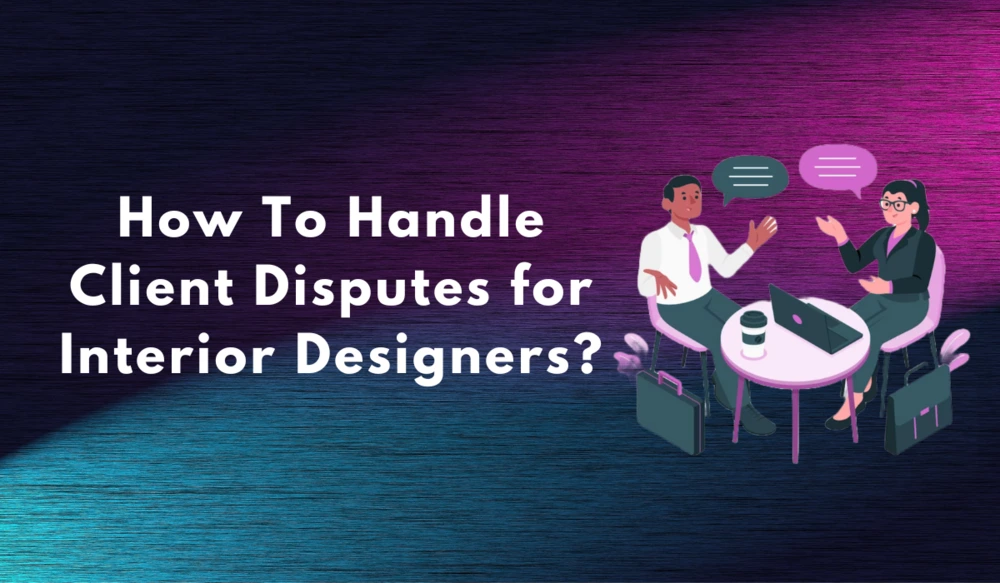Interior Design Client Dispute
As an interior designer, you create beautiful spaces that delight your clients. But what if a client is dissatisfied with your work or disputes your fees? How can you effectively handle these situations?
No matter how hard we try, there could be times when things don’t go as smoothly as planned. Worried about it? No longer need to worry. For every problem, there comes a solution!
Here, we’ll discuss 10 tips on effectively resolving client disputes and managing different types of interior design clients. Not only this, but we’ll also guide you through the process of attracting the best clients and building effective relationships with them. By discovering the tricks of the resolution, you will also be able to convince them that YOU are the best fit for their interior design needs.
So, what are you waiting for? Let’s begin this amazing journey of the trade of a successful interior design business!
Also, Read: 10 Best Client Management Tips for Interior Designers
10 Tips on How to Resolve Client Disputes or Handle Difficult Clients?
Dealing with clients can sometimes become a really challenging task for interior designers.
Even the most experienced designer sometimes encounters difficult interior design clients, leading to a potential dispute.
Here are the top tricks for dispute resolution, and ensure that your project ends on a positive note.
1. Communicate effectively
Communication is the key to resolving any dispute. Communication issues in the interior design business have led to a negative customer experience for about 30% of individuals.
Thus, clear and effective communication is crucial to solving misunderstandings between you and your clients. Talk to your client and share what the project entails, the timelines, budget constraints, if any, and limitations that may arise while working.
You can also gather continuous insights to solve common problems and validate design ideas from your client before investing time and money. The key here is to construct a collaborative environment by considering why your customers need interior design solutions and how your team can offer the best services.
Quick Read: 15 Ways To Improve Customer Service for Interior Design Business
Image Credit: freepik.com
2. Limit their options
Being an interior designer, you might encounter clients who are indecisive and feel confused with the numerous options available to them. You can narrow down the choices that are suitable for them. Limiting the options that you offer helps ease the decision-making process and prevents disputes from arising.
Start with understanding the client’s needs and preferences. Ask them questions regarding their lifestyle, taste and budget to curate choices that fit within that specific scope.
3. Populate accordingly
To work well with interior design clients, it’s crucial to understand their vision and preferences. However, sometimes there may be a disconnect between what the client wants and what you envision for the project. In that case, finding a balance that satisfies both parties is important.
One way to do this is by presenting multiple options and visual aids, which might lessen their concern about certain choices and ultimately lead to a more coordinated final result.
Also, Read: 20 Client Presentation Tips for Interior Designers
Image Credit: freepik.com
4. Document everything
Proper documentation can be a game changer in the interior design business, especially in situations of dispute with clients. Keep records of all conversations, agreements and decisions made during the entire project discussion to prevent misunderstandings. It can include emails, contracts, meeting minutes and any other relevant communication.
In addition to keeping conversation track, you should accurately document any changes or alterations made to original plans with reasons why they were necessary. It will ensure that everyone is on the same page and clearly understands what was agreed upon and provides evidence in case of disputes.
Suggested Read: A Guide To Client Process Document for Interior Designers
Image Credit: pcmag.com
5. Offer solutions rather than excuses
An interior designer should always be a solution-oriented individual. When faced with difficult situations, especially client disputes, it’s crucial to offer solutions instead of excuses.
It’s equally vital to maintain transparency regarding challenges in implementing the changes. Begin by actively listening and understanding the client’s concerns, showing empathy and acknowledging their viewpoint. Then, present alternatives that align with their preferences while maintaining the overall design concept.
When suggesting alternatives, it should be kept in mind that quality doesn’t get compromised at any single point. Being a problem solver always builds trust and turns disputes into opportunities.
Related Read: 15 Problems Most Interior Design Business Faces
6. Establish and maintain professional boundaries
Building professional boundaries with your interior design clients is crucial in any profession so in interior designing. Along with building a positive relationship with them, designers must protect their work and themselves.
The first step is to set clear expectations and have a contract that both parties agree on before initiating the project. The skill of saying ‘No’ is also crucial to maintain professional limits.
Referring clients to other professionals or refusing unreasonable requests ensures professionalism. It provides a framework for successful project outcomes.
7. Use mediation when required
Mediation can be a valuable tool to resolve client disputes in the interior design business. Involving a third-party mediator can help find a mutually agreeable solution. The reason behind this is the unbiased opinion that a third-party individual can give.
The mediator approach is not always required and is particularly helpful when emotions are high and communication is breaking down at the moment. The mediating individual creates a safe space and conducive environment for dialogue, leading to resolving the problem.
Quick Read: How To Build An Interior Design Team for Your Design Projects?
Image Credit: freepik.com
8. Don’t make promises you cannot keep
You must have heard the saying, “Honesty is the best policy.” It proves the best policy when it comes to managing client expectations by never promising specific design projects and pieces of furniture beyond the capacity of an interior design business.
Instead, communicate the realistic and feasible outcome that can be produced within the set budget and timeline.
Being transparent will make you come across as a trustworthy and reputed professional designer in front of your clients. Quality work delivered on time is far more valued than unrealistic promises that cannot be fulfilled.
Also, Read: How to Write an Interior Design Proposal to Win Your Clients?
9. Seek feedback regularly
Seeking feedback regularly from clients is significant for any business owner. According to the SurveyMonkey Buyer trust report, 82% of people trust customer feedback instead of words promised by the company.
Hence, scheduling check-ins and sending out surveys helps designers receive constructive criticism. It lays the path for further improvements in their business practices. It’s also critical to actively listen and show empathy when receiving feedback.
Designers should always use feedback as an opportunity for growth and not take it personally. Ultimately, it will help them create more satisfied customers and new leads via word of mouth.
Recommended Read: How To Become An Interior Designer?
Image Credit: freepik.com
10. Follow up after completion
‘Following up’ might seem like a small gesture to you, but it goes a long way toward building lasting relationships with your interior design clients and improving your services. It shows your commitment to providing satisfaction and gives an opportunity to cater to any concern or feedback the client has.
Make sure to personalize your message and consider sending a small gift to make a lasting impression. This will set you apart from your competitors and lead to more successful customers.
5 Steps on How to Build Easy and Effective Client Relationships
Now that you know how to resolve your client disputes effectively, here’s a step-by-step guide to building effective client relationships and a thriving interior design business.
Step 1: Research your client well before the initiation
The very first step in building an easy and effective client relationship is to research the client. A thorough research to understand a client’s preferences and needs can make you a pioneer in your industry.
The approach involves analyzing the client’s website and social media accounts for their style and aesthetics. Look for the space for which they require the makeover. A living room or dining room?
What kind of sofas would you include in your design? Which paint colors would look good? Should they use texture or use wallpaper? Would they prefer diy or a natural material? Extensive research on these aspects can help you understand your client better.
Also, Read: How To Find Your Niche As An Interior Designer?
Image Credit: freepik.com
Step 2: Establish communication
After thoroughly researching your potential clients, the next step you should follow is to establish a flow for communication. You can use multiple available communication channels, including email, phone calls, or social media.
However, you must ensure to respond promptly with professional etiquette. It’s important to reach out to your clients with a clear message emphasizing how your services benefit them.
Focus on building trust by showing interest in their project and asking open-ended questions. It will help you build a strong foundation for a successful working relationship.
Quick Read: How To Pick The Right Interior Design Clients and Projects?
Step 3: Develop a rapport
Once you have established contact with your interior design clients, developing a rapport is next. Building a good rapport takes time, but the rewards are worthwhile. Some of the key factors for this approach are active listening, empathy and authenticity for creating trust:
- Engage in meaningful conversations beyond project details
- Show interest in their personal life while maintaining professionalism at the same time
- Understand your client’s point of view.
All the above factors would lead a designer to get referral customers and repeat business.
Also, Read: 15 Ways To Get Local Clients for Your Interior Design Business
Image Credit: freepik.com
Step 4: Build ethos
The most important thing to make any business successful is to build trust. Without trust, no homeowner would feel comfortable working with or recommending you to others.
To establish trust in interior design, honesty and transparency are key. Be clear while explaining costs and timelines to your clients and deliver quality work. Respect their opinions and preferences throughout the process.
It has been observed that loyal customers are five times more likely to purchase again from an individual or a company. Thus, building trust leads to satisfied clients who return for future projects.
Step 5: Nurture the relationship
Building relationships is not just enough. Nurturing the connection over time is what builds a successful client relationship.
How effective your after-sales services set an interior designer business apart from its competitors. Providing personalized consultations could strengthen your bond with your clients.
Keep them informed of new design trends going on in the market and your offerings through newsletters or emails. It will lead to creating a connection beyond business.
Also, Read: 10 Powerful Networking Tips for Interior Designers
Image Credit: freepik.com
How to Manage Different Types of Clients?
Managing different types of clients effectively is a crucial aspect of running an interior design business. Each individual has a unique personality and preferences. Learn how to navigate the differences and create positive relationships with all your clients. Here are some strategies for managing diverse clients:
1. Adapt a suitable communication style
Different types of clients have different communication preferences. Some clients prefer quick and frequent updates, while others do not want regular check-ins.
By understanding each client’s style, you can avoid misunderstandings and maintain clear lines of communication throughout the project.
2. Set expectations from the outset
Designers should be transparent about all their services to interior design clients for real-estate makeovers. Timelines, budgets and all other information affecting the project’s outcome should clearly be communicated to the client to build trust and avoid discrepancies.
3. Understand the dynamics of clients
It’s essential to recognize that some clients want constant input on every decision taken on the project. On the other hand, others are happy to provide some general guidelines.
As a result, it’s crucial to recognize these dynamics and adjust your approach to accommodate clients who prefer to be more hands-on during the design process.
4. Be empathetic
Empathy helps manage different types of clients successfully. An interior designer should always try to put themselves in the client’s shoes. Showing respect towards them and listening to them actively without interrupting through conversation could make them your potential repeat customers.
By applying these strategies to specific situations along with excellent quality work, you will be able to manage diverse clients with expertise.
Also, Read: 7 Best Interior Design Communities
How To Convince Clients That You Are The Best Fit For Them?
In the highly competitive era of the interior design business, generating new clients and retaining existing ones can be challenging. But you don’t have to worry about these things.
By following these tips and tricks, you can establish yourself as a unique designer and an expert in interior designing:
1. Learn the art of persuasion!
To persuade the client:
- Convey your message effectively to your client.
- Show them why they need an interior designer like you in the first place.
- Highlight how a well-designed makeover of the space can improve their daily life and show what unique and new design offers you have for them.
2. Showcase your portfolio!
Along with persuasion, logic and trust-building are also essential. By showcasing your portfolio and highlighting your unique strengths as a designer, you can convince them why you are the perfect choice for their needs.
3. Provide testimonials from previous clients
By providing testimonials from previous clients who were satisfied with your work, you can add credibility for your potential clients. It will also give your future clients a glimpse of what they can expect when working with you.
4. Solve their dilemmas efficiently
During consultation time with clients, try to offer solutions instead of just presenting problems. Clients want someone who can solve their design dilemmas creatively. Show enthusiasm and passion for each project, which will help establish a strong rapport between you and the client.
Also, Read: How To Get More Sales Qualified Leads For Your Interior Business?
Wrapping Up!
Interior designers must know how to handle client disputes to ensure the success of their business. Thus, they should be equipped with effective conflict-resolution strategies and excellent communication skills.
To prevent disputes from escalating, active listening and maintaining professionalism are the key to success. Both parties can reach satisfactory outcomes by handling difficult clients with patience and proficiency.
In this regard, Foyr Neo can help designers provide top-notch services to their clients with its advanced 3D visualization tools and features. In conclusion, mastering the art of resolving client disputes is crucial for long-term success in the interior design industry.
Use Foyr Neo tools to achieve this goal and enhance your customer service. You can streamline your design process and offer your clients an exceptional experience with Foyr.
FAQs
1. How do interior designers deal with difficult clients?
Interior designers can deal with difficult clients by establishing clear communication, listening to their needs, setting realistic expectations, and finding creative solutions to meet their demands.
2. How do designers settle disputes?
Designers settle disputes by first understanding the root cause of the conflict, proposing potential solutions, and negotiating with all parties involved to find a mutually agreeable resolution. Keeping open communication and remaining professional is key to settling any disputes productively.
3. How do interior designers talk to clients?
Interior designers talk to clients by actively listening to their needs, asking clarifying questions, and using clear and concise language to convey their ideas and recommendations. They also use visual aids such as sketches, mood boards, and 3D renderings to help clients better visualize the final outcome of the project.
4. How do you handle interior clients?
Handling interior design clients typically involves establishing a clear communication plan and building a positive relationship with the client. This includes actively listening to their needs, understanding their design preferences and goals, and providing them with creative and practical solutions that meet their expectations.

















